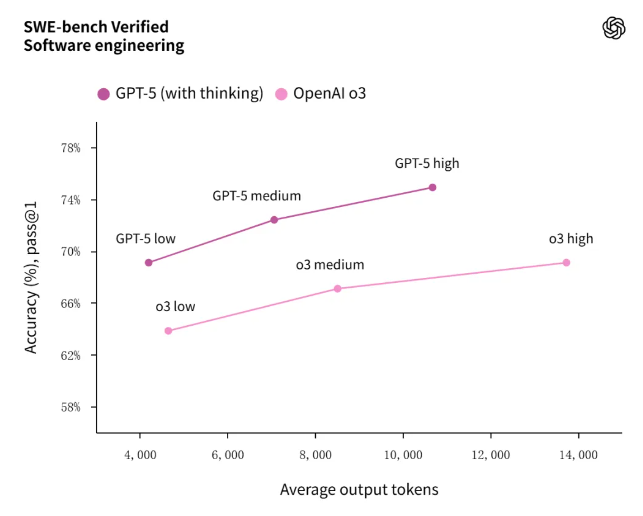At 1:00 AM Beijing Time today, the company OpenAI officially announced the launch of the GPT-5 model. Sam Altman, CEO of OpenAI, stated at the event that this is an important step towards artificial general intelligence (AGI), and interacting with GPT-5 is as natural and smooth as communicating with a human expert.
During the event, the OpenAI team introduced the GPT-5 model in detail. The model performed exceptionally well in multiple benchmark tests, including Swe Bench, setting new standards. Its key improvements focus on enhancing reliability and accurately explaining facts.
According to the release plan, OpenAI announced that GPT-5 will be available to free, Plus, and Pro subscription users. Free users can use it for free but with quota limitations; Plus and Pro subscribers will enjoy higher usage privileges.
In the live demonstration, GPT-5 showed remarkable capabilities. When asked to explain the Bernoulli effect, it responded quickly; while creating visual effects, although the response time was slightly longer, it completed the task excellently. Users can also ask GPT-5 to "think deeply" or "be more precise" in real prompts, even seeing its thought process. In the programming demonstration, GPT-5 amazed everyone by outputting over 200 lines of code in a few minutes, creating a website containing many visual and audio elements aimed at helping couples learn French.
Aside from its programming capabilities, GPT-5 will soon introduce a voice mode. During the live stream, ChatGPT responded with just one word in voice mode and summarized "pride and bias as 'interpersonal relationships'."

The memory (Memory) function of ChatGPT has also been upgraded. Pro, Plus, and Teams subscribers can connect ChatGPT to their Google accounts, access calendar content, and achieve integration with Gmail and Google Calendar. This means GPT-5 can gain more contextual abilities based on user daily schedules and even remind users to reply to emails. This feature will first be available to Pro users next week, followed by expansion to Plus and Teams subscribers.
Regarding safety and preventing deception, OpenAI has also made significant efforts. The goal of GPT-5 is to help users as much as possible within safety limits. Unlike previous models such as o3, which directly refused to answer due to safety reasons, GPT-5 will explain why it cannot help and guide users to third-party sources or manuals for information.

The newly released GPT-5 series includes three models: GPT-5, GPT-5mini, and GPT-5nano, all with a context length of 400K and a maximum output of 128K tokens. In terms of API pricing, GPT-5 costs $1.25 per million tokens for input and $10 for output; GPT-5mini costs $0.25 per million tokens for input and $2 for output; GPT-5nano costs $0.05 per million tokens for input and $0.40 for output.

Notably, GPT-5 is the first to adopt an "embedded triple-integrated architecture," composed of GPT-5-main, GPT-5-thinking, and a real-time routing mechanism, along with a mini version that automatically switches when the quota is exhausted. The real-time routing mechanism acts like a "traffic controller," scheduling the most suitable model within milliseconds based on conversation scenarios, complexity, tool requirements, and user intent, continuously evolving through real user feedback. Free version ChatGPT users can experience GPT-5, but with a usage limit; exceeding it will switch to GPT-5-mini. Plus, Pro, Team, Enterprise, and Education users will receive higher quotas or unlimited access according to their subscription level. Pro users can exclusively access the GPT-5Pro mode.
In multiple benchmark tests, GPT-5 has achieved remarkable results. In the 2025 U.S. AIME mathematics competition, the base version scored 94.6%, and after enabling Python, it reached 99.6%, with the Pro version achieving a perfect score when using Python tools. In the authoritative software engineering test SWE-bench, GPT-5-thinking set a record of 74.9%, far surpassing o3's 69.1%. In the HealthBench Hard subset of the health field, GPT-5-thinking jumped from o3's 31.6% to 46.2%, ranking first globally. On the security dimension, the high-risk scenario error rate of GPT-5 is 50 times lower than that of GPT-4o, and the potential hallucination rate is 8 times lower than that of o3, achieving zero errors in global health scenarios. However, during the live stream, there was a small incident where the official presentation PPT mistakenly depicted the bar chart of o3 on SWE-bench as being the same height as 4o, leading to jokes from the audience.


OpenAI emphasized that the training data for GPT-5 still comes from the public web, cooperative authorizations, and user-generated content, but through an upgraded filtering strategy and Moderation API, the risks of privacy and harmful information have been significantly reduced; reinforcement learning has been used for the first time in the "think first, then answer" reasoning pipeline, improving the model's logic and accuracy.
